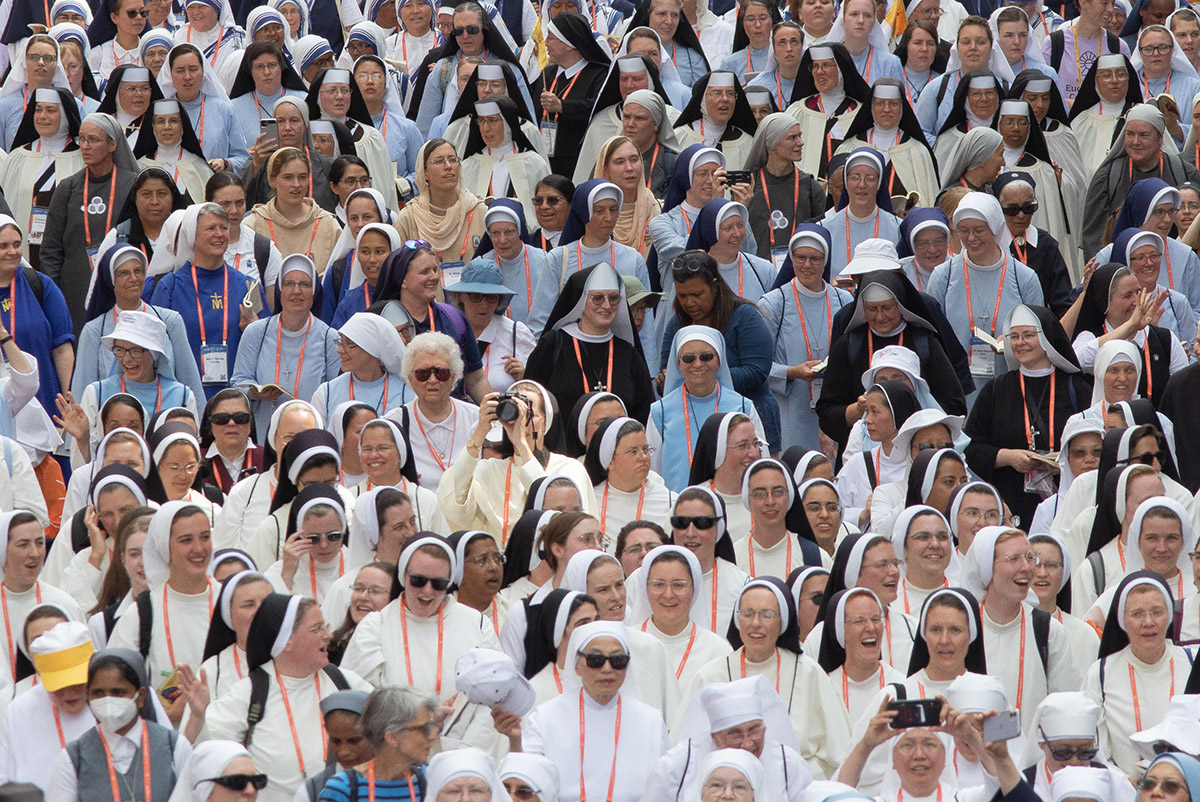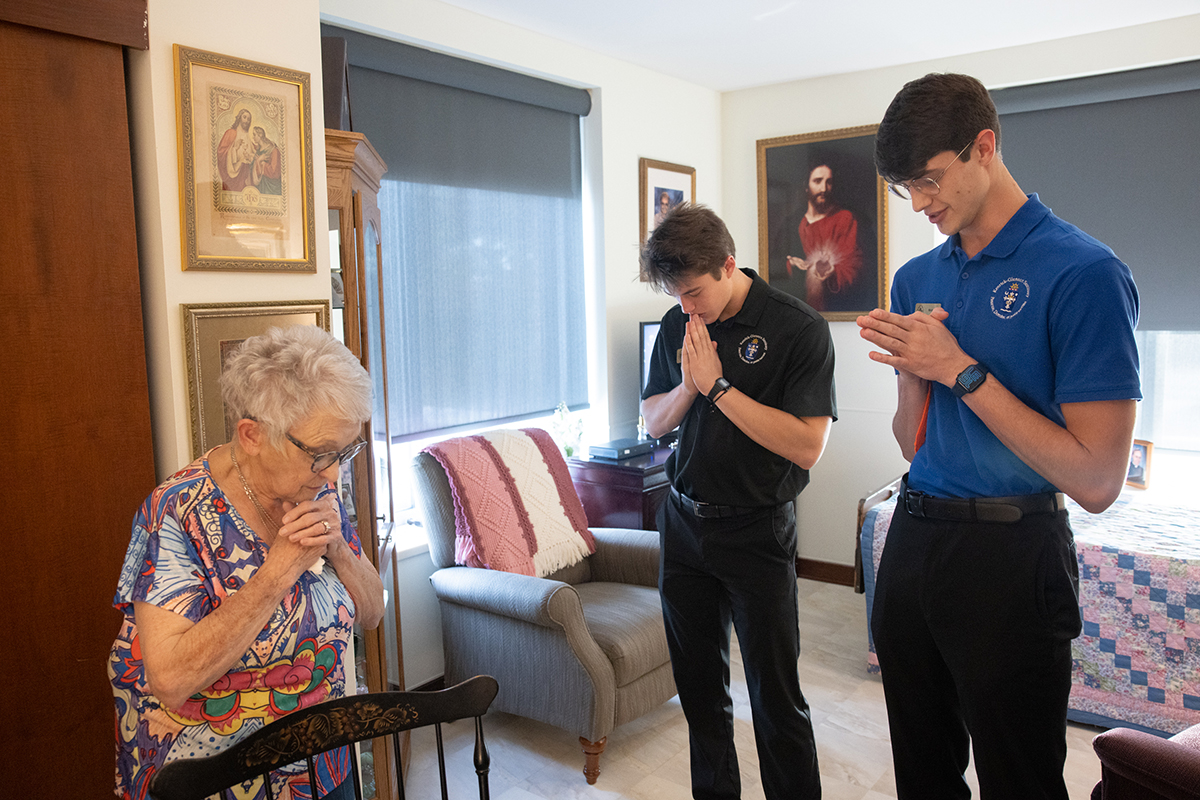Calligrapher Carol Savage finds joy in blending her Catholic faith, artistic talents

Savage will host workshop on calligraphy and The Saint John’s Bible in September

Carol Savage would observe with fascination as her teacher Sister Miriam James embellished her writing with serifs and curlicues.
Years later, she realized that those little flourishes left a deep impression upon her as a child. It was the beginning of her journey into the fine arts and eventually a career as a professional calligrapher.
Savage has found great joy in blending her Catholic faith and artistic talents. Earlier this year, she began offering workshops on calligraphy and The Saint John’s Bible at the Pallottine Retreat and Conference Center in Florissant. She also will be featured at the second annual Catholic Art Festival Sept. 23 at Epiphany of Our Lord Church in south St. Louis.
“My faith is the most fundamental element in my life,” said Savage, a member of Incarnate Word Parish in Chesterfield. “Calligraphy allows me to express my humanity and Catholic faith and share it with others,” whether that’s with a client seeking hand-lettered wedding invitations, teaching others at workshops or connecting with fellow Catholic artists through the Catholic Artist Network.

Savage took private art classes as a child. In high school, she designed part of an alphabet, her first attempt at hand-lettering. She went to college to become an art teacher and later taught at several Catholic schools over the years while raising a family.
In a college graphic design class, her instructor mentioned that she could make a professional career in calligraphy. When she and her husband, Bruce, married in 1978 at St. Francis Xavier (College) Church, Savage hand-lettered her own wedding program. That was what eventually ignited her business, Calligraphy for Life’s Celebrations.
Savage found another intersection of faith and calligraphy with The Saint John’s Bible, which she has incorporated into her calligraphy workshops. An effort of the Benedictine-sponsored St. John’s University in Collegeville, Minnesota, The Saint John’s Bible is hand-written and hand-illuminated and the first to be commissioned by a Benedictine monastery in 500 years.
“Here is something this monumental that was being done in a completely novel way,” Savage said. “What’s the thrust of our whole Christian writing system? It’s all God’s word. You take God’s word that was written in Aramaic and Greek and in Latin and stop for 500 years. Then you jump to the 20th century, and you have Scripture being hand-written in English with illuminations … that can reach deep into all of the world’s traditions, so that everyone on the face of the earth can recognize elements that are familiar to them.”
Savage finds the most powerful part of The Saint John’s Bible to be the gold surfaces found in the illuminations. “Everyone is reflected in that and brought into the presence of the word of God,” she said. “It’s so powerful.”
During a visit to Pallottine earlier this year to plan an ACTS retreat with her parish, Savage noticed that the retreat center had a replica of The Saint John’s Bible on display. Pallottine was looking for new ways to offer events for the community and asked Savage if she’d offer a calligraphy workshop incorporating elements from the Bible. The first was held in June.

The workshop intertwines hand-lettering (students learn how to write a hand called uncial) and the illuminations found in the Bible. Savage also touches on visio divina, the practice of praying with images, or divine seeing. “You’re looking at the lettering, and how does that speak to you?” she said. “What emotions and feelings do you experience?”
Donald Jackson, who was commissioned to produce The Saint John’s Bible, once said that perfection is not an option. Savage elaborated, saying that the imperfections found in hand-lettering reflect our natural human condition. “In creating beauty, God’s creation is perfect,” she said. “Ours will never be perfect because we’re not perfect. The art of lettering is an attempt to bring beauty into whatever we’re writing.”
Calligraphy is like a ballet, Savage said. “It’s no pressure, then pressure, no pressure, no pressure, pressure on the down stroke,” she said as she demonstrated by stroking a broad-nib pen along a piece of paper. “We are drawing toward our body. You don’t push it. The pressure is allowing the nib tip to spread open when you change the pressure, you change the width of the line. It’s very rhythmic. Calligraphy is a very relaxing activity; it should be soothing. You can’t be in a state of restlessness, anxiety or anger and do any kind of lettering — unless that’s the kind of emotion you want reflected in your lettering.”
Through her art, Savage said her faith has been illuminated in immeasurable ways. “Lettering is personal and engages our humanity, both the heart and the mind,” she said. “Calligraphy has allowed me to be an artist in a meaningful way. My studio is where I do my mission work. People bring me things and tell me stories of their life, and I get to connect with them.”
Calligraphy workshop
Carol Savage will offer two workshops on calligraphy and The Saint John’s Bible this fall at Pallottine Retreat and Conference Center in Florissant.
A four-week program will be offered on Wednesdays from 10 a.m.-noon beginning Sept. 6. Cost of the program is $90; an option including the program and lunch afterward is $140.
Savage also will lead a four-week workshop on Mondays from 6-8 p.m. beginning Sept. 11. Cost is $90.
To register, visit www.pallottineretreat.org
Savage Carol Savage would observe with fascination as her teacher Sister Miriam James embellished her writing with serifs and curlicues. Years later, she realized that those little flourishes left a … Calligrapher Carol Savage finds joy in blending her Catholic faith, artistic talents
Subscribe to Read All St. Louis Review Stories
All readers receive 5 stories to read free per month. After that, readers will need to be logged in.
If you are currently receive the St. Louis Review at your home or office, please send your name and address (and subscriber id if you know it) to subscriptions@stlouisreview.com to get your login information.
If you are not currently a subscriber to the St. Louis Review, please contact subscriptions@stlouisreview.com for information on how to subscribe.







